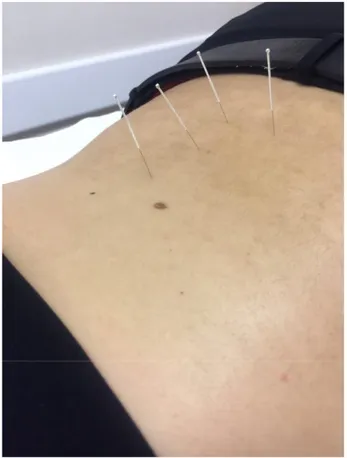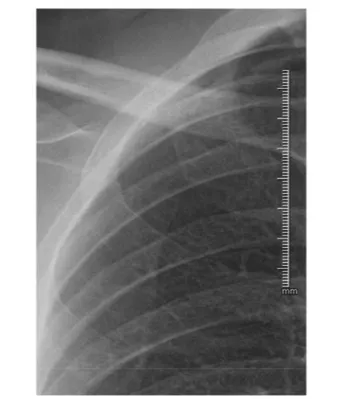R a d i o l o g y C a s e R e p o r t s 1 3 ( 2 0 1 8 ) 1 2 4 6 – 1 2 4 8
Available online at www.sciencedirect.com
journal homepage: www.elsevier.com/locate/radcr
Case Report
A case with iatrogenic pneumothorax due to deep dry needling
Tugce Uzar
a, Irem Turkmen
a, Elif Berber Menekse, MD
b, Adem Dirican, MD
c,
Pankina Ekaterina, MD
d, Sevket Ozkaya, MD
e,aMedical Intern, Bahcesehir University, Faculty of Medicine, Istanbul, Turkey
bPhysical Therapy and Rehabilitation, Istinye University, Faculty of Medicine, Department of Physical Therapy and Rehabilitation, Istanbul, Turkey
c Samsun Medicalpark Hospital, Department of Pulmonary Medicine, Samsun, Turkey
d Bashkir State Medical University, Faculty of Medicine, Department of Pulmonary Medicine, Ufa, Russia e
Bahcesehir University, Faculty of Medicine, Department of Pulmonary Medicine, Istanbul, Turkey
a r t i c l e i n f o
Article history: Received 24
April 2018 Revised 16 August 2018 Accepted 17 August 2018
Available online 20 September 2018
Keywords:
Dry needling Pneumothorax Radiology
a b s t r a c t
Deep dry needling is an evidence-based treatment technique that is accepted and used by physical therapists for treatment of musculoskeletal pain. We present a case of iatrogenic pneumothorax due to deep dry needling over the posterior thorax. A 36-year old presented with right chest pain 2 hours after dry needling for pain in his back muscles. Chest radio-graph suggested small right pneumothorax and the finding was confirmed by computed tomography. Not only should practitioners and their patients be aware of potential compli-cations of dry needling, but also physicians who might see patients with complications.
© 2018 The Authors. Published by Elsevier Inc. on behalf of University of Washington. This is an open access article under the CC BY-NC-ND license.
Introduction
Pneumothorax is a very rare but serious complication associ-ated with acupuncture and dry needling around the thoracic region. Dry needling is a technique where a solid, very fine needle is inserted into a soft tissue in the body. Trigger point dry needling is an invasive procedure where an acupunc-ture needle is inserted into the skin and muscle. It is aimed at myofascial trigger points which are hyperirritable spots in skeletal muscle that are associated with a hypersensitive palpable nodule in a taut band. Trigger point dry needling
can be carried out a superficial or deep tissue level. Two tech-niques commonly used by physiotherapists are superficial dry needling and deep dry needling (DDN). Both techniques are used in the treatment of pain and referred pain from my-ofascial trigger points MTrp but superficial dry needling can also be used for treating pain from ligaments and joints. The primary areas associated with acupuncture or dry needling-induced pneumothorax are the regions of thorax including the upper trapezius, paraspinal, medial scapular, and sub-clavicular regions as seen in Figure 1 [1–3]. Present a case with iatrogenic pneumothorax due to DDN over the tho-rax.
Competing interest: The authors declare that they have no competing interests. Corresponding author.
E-mail address: ozkayasevket@yahoo.com (S. Ozkaya).
R a d i o l o g y C a s e R e p o r t s 1 3 ( 2 0 1 8 ) 1 2 4 6 – 1 2 4 8
1247
Fig. 1 – The technique of deep dry needling of thorax including the paraspinal, medial scapular, and subclavicular regions.
Case presentation
A 36-year-old male was admitted to our emergency depart-ment with a complaint of right chest pain. There was no rele-vant past medical history. He had undergone dry needling for pain in his back muscles 2 hours earlier and was now experi-encing chest pain. Chest auscultation revealed the decreased breath sounds on the right hemithorax. Chest radiography ini-tially seemed to be normal (Fig. 2A), but a minimal pneumoth-orax was seen as a thin line on the right hemithorax (Arrows in Fig. 2B). High-resolution computed tomography confirmed theiatrogenic pneumothorax due to DDN over the right hemitho-rax (Figs. 3 and 4). The entrance areas of the needles to lung parenchyma were also seen in Figure 5A. The areas of DDN on patient’s chest were shown in the Figure 5B. The pneumotho-rax was fully recovered without any intervention on the third day (Fig. 6).
Discussion
Dry needling is an evidence-based treatment technique that is accepted and used by physical therapists. This treatment approach focuses on releasing or inactivating muscular trig-ger points to decrease pain, reduce muscle tension, and assist patients with an accelerated return to active rehabilitation [4].
Fig. 2 – Chest roentgenography is looking as normal
(Fig. 1A) but when looked carefully, pneumothorax appears as thin line there in the visceral pleura on the right hemithorax (arrows in Fig. 1B).
Fig. 3 – High-resolution computed tomography (HRCT)
demonstrated the iatrogenic pneumothorax due to deep dry needling (DDN) over the right hemithorax.
Fig. 4 – High-resolution computed tomography (HRCT)
demonstrated the iatrogenic pneumothorax due to deep dry needling (DDN) over the thorax (Coronal plane).
1248
R a d i o l o g y C a s e R e p o r t s 1 3 ( 2 0 1 8 ) 1 2 4 6 – 1 2 4 8Fig. 5 – The entrance area of the needles to lung parenchyma are also seen in Figure 4A (arrows). The areas of DDN are showing on the patient’s chest in the Figure 4B. DDN, deep dry needling.
dence of pneumothorax [5–7]. Respiratory failure was reported in a patient with iatrogenic bilateral pneumothorax and sub-sequent tension pneumothorax due to dry needling used in the treatment of myofascial pain [8].
In conclusion, not only must physiotherapists and their pa-tients be aware of potential complications of DDN, but also doctors who might see patients with complications of this procedure. Detailed history-taking and clinical suspicion are important for the definitive diagnosis of pneumothorax in these cases.
Consent
Written informed consent was obtained from the patient for publication of this manuscript and any accompanying images.
Fig. 6 – The pneumothorax was fully recovered without any intervention on the third day. There is no pneumothorax line on chest roentgenography.
When done correctly, this can be an effective way to minimize the chance of penetrating an unwanted region, such as the pleural cavity. Accidents can happen, however, when the nee-dle slips along the side of a rib and penetrates further than anticipated, with the result compromising the pleural lin-ing and a pneumothorax. Several studies have demonstrated that needling of the serratus anterior, rhomboids, supraspina-tus, iliocostalis, and the lower cervical paraspinals can result in pneumothorax. The largest prospective survey of adverse events of acupuncture found 2 cases of pneumothorax related to 2.2 million acupuncture sessions in 0.22 million patients, but we do not know what proportion of the 2.2 million treat-ments surveyed involved needling over the thorax. DDN over the thorax is very likely to be associated with a higher
inci-Authors’ contributions
TU, IT, EBM, AD, and so have made substantial contributions to conception and design, or acquisition of data, or analysis and interpretation of data. All authors read and approved the final manuscript.
Supplementary materials
Supplementary material associated with this article can be found, in the online version, at doi:10.1016/j.radcr.2018.08.019.
R E F E R E N C E S
[1] Bensoussan A, Myers SP, Carlton AL. Risks associated with thepractice of
traditional Chinese medicine: an Australian study. Arch Fam Med 2000;9:1071–8.
[2] Cummings M, Ross-Marrs R, Gerwin R. Pneumothoraxcomplication of
deep dry needling demonstration. AcupunctMed 2014;32:517–19.
[3] Dommerholt J, Del Morel O, Grobli C. Trigger point dry
needling. J Man Manipulative Ther 2006;14(4):70–87.
[4] Halle JS, Halle RJ. Pertinent dry needling considerations for minimizing adverse effects-part one. Int J Sports Phys Ther 2016;11(4):651–62.
[5] White A. A cumulative review of the range and incidence ofsignificant
adverse events associated with acupuncture.Acupunct Med
2004;22:122–33.
[6] Witt CM, Pach D, Brinkhaus B, et al. Safety of acupuncture:results of a prospective observational study with 229,230patients and introduction of a medical information andconsent form. Forsch Komplementmed 2009;16:91–
97.
[7] McCutcheon Leigh, Yelland Michael. Iatrogenicpneumothorax: safety
concerns when using acupuncture ordry needling in the thoracic region.
Phys Ther Rev2011;16(2):126–32.
[8] Kozacı N, Yalcın NC, Ozkaya M, Kırpat V, Celik A. A Rare Complication Caused by Dry Needling Method: Tension Pneumothorax. Respir Case Rep 2017;6(3):145–8.

